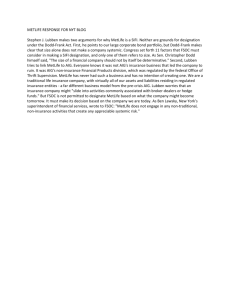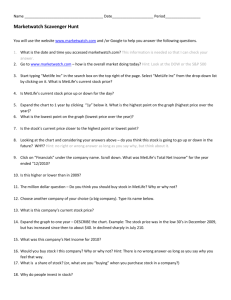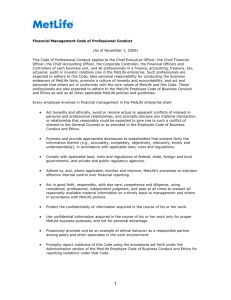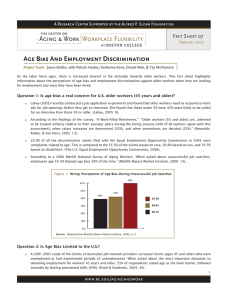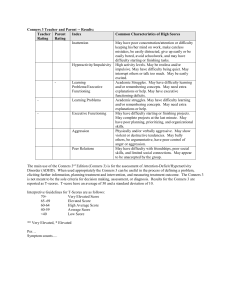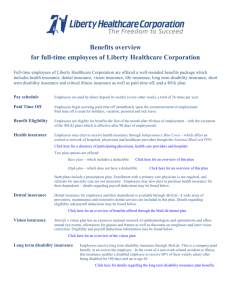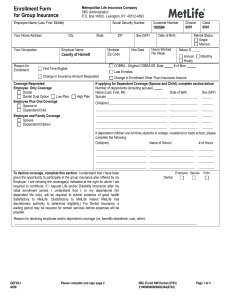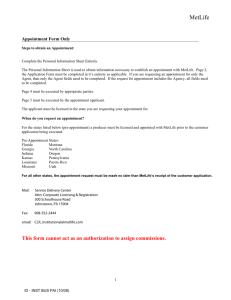The Winner is: Innovation or Commoditization?
advertisement
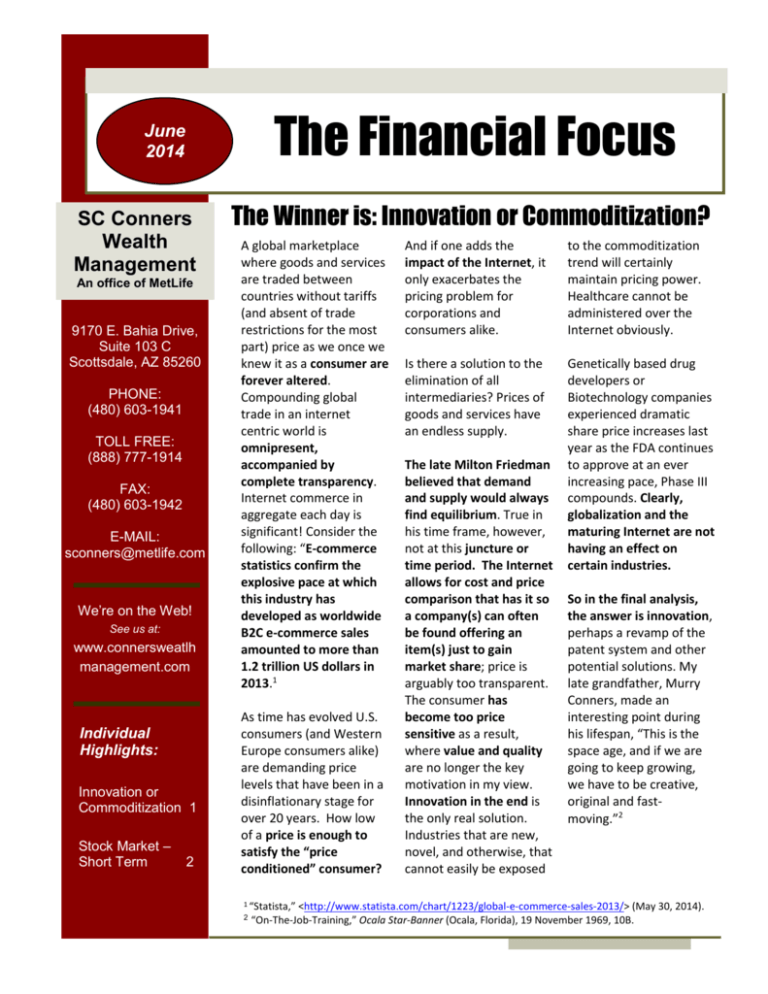
The Financial Focus June 2014 SC Conners Wealth Management An office of MetLife 9170 E. Bahia Drive, Suite 103 C Scottsdale, AZ 85260 PHONE: (480) 603-1941 TOLL FREE: (888) 777-1914 FAX: (480) 603-1942 E-MAIL: sconners@metlife.com We’re on the Web! See us at: www.connersweatlh management.com Individual Highlights: Innovation or Commoditization 1 Stock Market – Short Term 2 The Winner is: Innovation or Commoditization? A global marketplace where goods and services are traded between countries without tariffs (and absent of trade restrictions for the most part) price as we once we knew it as a consumer are forever altered. Compounding global trade in an internet centric world is omnipresent, accompanied by complete transparency. Internet commerce in aggregate each day is significant! Consider the following: “E-commerce statistics confirm the explosive pace at which this industry has developed as worldwide B2C e-commerce sales amounted to more than 1.2 trillion US dollars in 2013.1 As time has evolved U.S. consumers (and Western Europe consumers alike) are demanding price levels that have been in a disinflationary stage for over 20 years. How low of a price is enough to satisfy the “price conditioned” consumer? 1 “Statista,” 2 And if one adds the impact of the Internet, it only exacerbates the pricing problem for corporations and consumers alike. to the commoditization trend will certainly maintain pricing power. Healthcare cannot be administered over the Internet obviously. Is there a solution to the elimination of all intermediaries? Prices of goods and services have an endless supply. Genetically based drug developers or Biotechnology companies experienced dramatic share price increases last year as the FDA continues to approve at an ever increasing pace, Phase III compounds. Clearly, globalization and the maturing Internet are not having an effect on certain industries. The late Milton Friedman believed that demand and supply would always find equilibrium. True in his time frame, however, not at this juncture or time period. The Internet allows for cost and price comparison that has it so a company(s) can often be found offering an item(s) just to gain market share; price is arguably too transparent. The consumer has become too price sensitive as a result, where value and quality are no longer the key motivation in my view. Innovation in the end is the only real solution. Industries that are new, novel, and otherwise, that cannot easily be exposed So in the final analysis, the answer is innovation, perhaps a revamp of the patent system and other potential solutions. My late grandfather, Murry Conners, made an interesting point during his lifespan, “This is the space age, and if we are going to keep growing, we have to be creative, original and fastmoving.”2 <http://www.statista.com/chart/1223/global-e-commerce-sales-2013/> (May 30, 2014). “On-The-Job-Training,” Ocala Star-Banner (Ocala, Florida), 19 November 1969, 10B. SC Conners Wealth Management An office of MetLife 9170 E. Bahia Drive, Suite 103 C Scottsdale, AZ 85260 PHONE: (480) 603-1941 TOLL FREE: (888) 777-1914 FAX: (480) 603-1942 E-MAIL: sconners@metlife.com We’re on the Web! See us at: www.connersweatlh management.com Written by: Steven C. Conners Investment Advisor Representative Financial Services Representative The Financial Focus Page 2 of 2 The Stock Market in the Short-Term The stock market in the short run is up, down, or gyrating sideways. More often than not, it can be based on emotion. The market is reactive as opposed to responsive. Reaction to news and the subsequent stock price movement is enough to make one sea-sick! At least leave your seat belt on when investing in the equity market. To be sure, the equity market often does create trends which may last a long while, whether it is a bullish or upward trend, or a bearish, downward trend. There is typically rational reasoning behind the trend. A reactionary market example is the aftermath of the housing crash and the ensuing credit crisis. Many panicked and sold. I sold for clients, but perhaps too soon as there was still a year left of gains. But, as far as stocks were concerned; panic set in, and dumping of a company’s stock was in turn the reaction. Contrast this to the Federal Reserve’s recent quantitative easing program. Quantitative easing went into a stagelike process that ultimately had investors respond in kind, with share prices increasing in value, as confidence levels increased. The bottom line, as I provide you with advice, it will be based (as always) as a response to a multitude of factors that are predicated on facts to accurately reflect not only opportunity but the riskadjusted return. Reactionary investing can be costly. Moreover, contrasting the speed of change in the stock market versus the Treasury markets, and accompanying credit markets, can be quite revealing. Bond prices generally are not as fickle. It is more of a reflection of price levels in aggregate and levels of economic activity. The bond market is not a great place for the quick buck on that hot stock tip you heard about at the cocktail party. Thus, it is a more intelligent market, and is generally one that is characterized by the target audience that invests in it, which more or less is for those seeking income and the potential for growth. This has it so many investors in the bond market(s) can be more complacent and are perhaps more settled in their respective holdings. Pricing is more reflective and “responsive”; serving as a thermostat on economic activity and general pricing levels on a macro-basis. This indeed can serve as an example of a responsive market as opposed to the above reactionary market distinction. The exception is of course the high-yield corporate bond market that does fluctuate more frequently in response to changes in the category of companies that carry low credit ratings. Furthermore, the highyield, corporate bond market, or (junk bonds) correlate to stocks, rather than the Treasury bond market. Lastly, highgrade and Treasury bonds can be more stable and more predictable as a result. The Financial Focus is a publication created by Steven C. Conners. The statements and opinions expressed in this article are those of Steven C. Conners and do not in any way reflect the views of MetLife. This material is for informational purposes only, and should not be construed as an offer to sell or solicitation of an offer to buy any security. MetLife makes no representation or warranty relating to the facts presented or that all material facts necessary to make an investment decision are presented. The information in this material is not intended to be personalized investment advice and should not be solely relied on for making investment decisions. MetLife and its representatives do not provide tax or legal advice. Please consult your tax or legal advisor for such guidance. Metropolitan Life Insurance Company (MLIC), New York, NY 10166. Securities and investment advisory services offered by MetLife Securities, Inc. (MSI) Member (FINRA/SIPC), a registered investment advisor. MLIC and MSI are MetLife Inc. companies. L0614378040[exp1114][AZ,CA,FL,IL,NJ]

